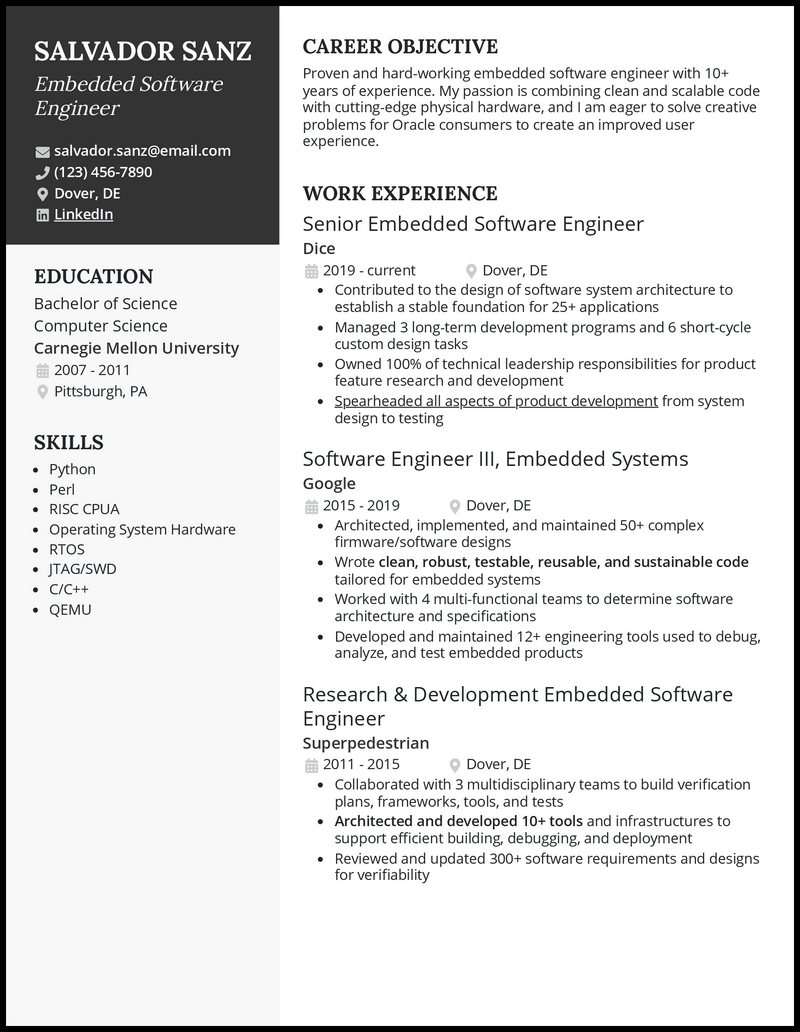You can do it all. You know hardware and you know how to build custom software for that hardware all the while managing the complexity of such projects.
How do you possibly include your entire skillset on your embedded developer resume? That’s where we can help.
Since starting BeamJobs, we’ve helped thousands of embedded software engineers land jobs, and these resume examples and guide are a highlight reel of what works (and what doesn’t).
Why this resume works
- Sending a cookie-cutter embedded software engineer resume is like lobbing a grenade into your career plans. Tailoring your masterpiece can have the opposite effect. How about we show you the ropes?
- Start by digesting the job posting—read it over once, twice, whatever it takes. Then, scribble down all the relevant keywords, skills, and expectations you find. Got them? Great! Then, weave most of these features into your piece to align perfectly with what the hiring company seeks.
What Matters: Your Work Experience & Skills
Just like you wouldn’t ask a dentist to do your plumbing, recruiters want to make sure you have the right tools for their embedded software engineer role.
Since embedded software engineering is such a blanket term and embedded systems change so drastically from one company to another, it is crucially important that you update your “skills” section for each role you apply to.
Here, recruiters are looking for a reason to throw your resume in the “no” pile. Don’t give them that reason!
Read the job description and include any skills mentioned that you know (i.e. that you’d be comfortable being interviewed on).
9 Top Embedded Software Engineer Skills
- C/C++
- Algorithms
- Micro-controllers
- Perl
- Python
- Design patterns
- Parallel programming
- Protocols: I2C, LIN
- IoT
Sample Embedded Software Engineer Work Experience Bullet Points
Now that you’ve passed the “skills” test, it’s time to showcase what you’ve done in your past roles.
The key is to focus on your impact, not on a list of your job responsiblities.
Talk about your specific work within the scope of a project then talk about the outcome of the overall project. This is the place to give context for your technical skills.
If a particular project you worked on comes to mind as you read the job description of the role you’re applying to, be sure to include it.
Here are a few examples:
- Built custom software in C++ for a micro-controller within an AC unit that reduced the cost of annual maintenance by 6%
- Improved the speed of an embedded system by 17% by changing the microprocessor without changes in materials cost
- Created automated testing infrastructure for custom code written for embedded system for the entire team which reduced error rates by over 50%
- Collaborated with leadership to come up with cost saving measures within product and re-wrote C++ code to accommodate new materials, saving ~$500K annually
Top 5 Tips for Your Embedded Software Engineer Resume
- Soft skills without context are meaningless
- Imagine someone came up to you and said, “I am organized.” One, you’d wonder why they’re talking to you. And two, you would have no context for what they’re talking about. The same goes for your resume skills section. Focus on your technical skills here.
- It’s all about your impact
- Your resume should not just be the bullet points from your job description. Rather, they should be the outcome of those responsibilities. So, instead of saying “managed embedded system,” you might say, “improved efficiency of embedded system by 7%,” for example.
- Specificity is key
- Because there are so many different kinds of embedded systems, the role of an embedded developer changes so much from role to role. That’s why your work experience should be as specific as possible in terms of what tools and technologies you’ve worked with.
- Focus on your work experience
- As soon as you have some real-world experience under your belt, your work experience should be the focus of your resume. A good rule of thumb, it should take up at least 75 percent of your resume. So, for example, if you’re 10 years out of school you don’t need to list all the relevant classes you took while in school.
- You don’t need a career summary
- Unless your career summary is going to tell a recruiter something new, it’s better to leave it out in favor of more work experience. A good way to make a summary valuable is to focus on your total career impact (in terms of revenue created, time saved, etc..).
Frequently Asked Questions
- How do I change my resume for each job I apply to?
- You’ll want to focus on changing two areas: your skills section and the projects you mention in your work experience. Read the job description and note any skills that are mentioned and any projects you’ve worked on that come to mind.
- How far back should my work experience go?
- Your work experience can go back as far as you need as long as the work experience is relevant to the role you’re applying to. If an embedded developer job you held 15 years ago is hyper relevant to a role you’re applying to for example, you should definitely include it!
- What do I put on my embedded software engineer cover letter?
- Your resume work experience bullet points should focus on the tools you used and the impact of what you did. Your AI cover letter is the place to give more context and more details about those projects on your resume.










